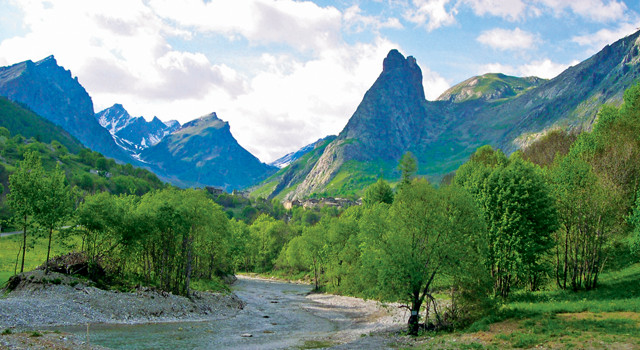
by Mary Caperton Morton Thursday, January 7, 2016

The mountains of the Dora Maira Massif, part of the Western Alps, surround the Maira Valley in northwestern Italy. Seismic data collected in the region suggests that, far below the massif, the buoyant continental crust of the Eurasian Plate is diving under the Adriatic Plate. Credit: Archenzo, CC BY-SA 3.0.
Continental crust was long thought to be too buoyant to subduct into the mantle, unlike denser oceanic crust, which descends into the mantle in many locations around the world. But the discovery of coesite — a type of silica formed at the extreme pressures present in subduction zones — in the Alps in 1984 challenged that long-held idea. Seismic evidence backing up claims that continental crust has indeed been subducted beneath the Alps has been scant, however, until now.
The European Alps are part of the Tethys Orogen, the largest ongoing continent-continent collision belt in the world, which extends from the Alps in the west to Tibet and Southeast Asia in the east. “The geology of the Western Alps has been studied for 200 years, which makes it one of most well-studied tectonic areas in the world,” says Liang Zhao, a geophysicist at the Chinese Academy of Sciences in Beijing and lead author of a new study in Geology presenting seismic data from beneath the mountain range. Despite the long history of geologic study, producing seismic profiles of the Western Alps has been difficult due to a strong seismic velocity discontinuity at a depth of 10 to 20 kilometers. “This is the reason why previous studies could not image the subduction of Eurasian [continental crust],” Zhao says.
In a new approach, Zhao and colleagues gathered data from the China-Italy-France Alps seismic survey, the first passive seismic transect of the entire Dora Maira Massif in southern France and northern Italy, where the coesite samples were originally found. The team reported evidence of the continental crust of the Eurasian Plate diving under the Adriatic Plate and extending to a depth of 75 kilometers, deep enough to produce the extreme pressures and temperatures needed to form coesite. “Our data demonstrate that the Eurasian lower crust underthrusts the Adriatic mantle,” he says, providing the first seismic evidence of subducted continental crust. The Adriatic Plate is made up of mostly continental crust that broke off from the larger African Plate during the Cretaceous.
The findings may have applications elsewhere along the Tethys Orogen, Zhao says. “We are not only interested in the Alps; we are also interested in improving the understanding of how a continent-continent orogen evolves. This project is part of a [larger project to] deploy several seismic arrays across the Tethys tectonic area.”
© 2008-2021. All rights reserved. Any copying, redistribution or retransmission of any of the contents of this service without the expressed written permission of the American Geosciences Institute is expressly prohibited. Click here for all copyright requests.